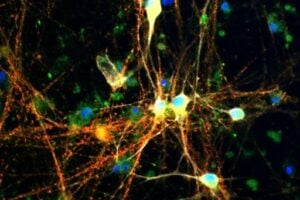People who follow the MIND or Mediterranean diet show fewer signs of Alzheimer’s in the brain, according to RUSH researchers. The results were published in the March 8 online issue of Neurology, the medical journal of the American Academy of Neurology.
The hallmark pathology elements of Alzheimer’s disease found in the brain are amyloid plaques and neurofibrillary tangles.
“These results are exciting. Improvement in people’s diets in just one area — such as eating more than six servings of green leafy vegetables per week, or not eating fried foods — was associated with fewer amyloid plaques in the brain similar to being about four years younger,” said study author Puja Agarwal, PhD.
“While our research doesn’t prove that a healthy diet resulted in fewer brain deposits of amyloid plaque, also known as an indicator of Alzheimer’s disease, we know there is a relationship, and following the MIND and Mediterranean diets may be one way that people can improve their brain health and protect cognition as they age.”
The MIND and Mediterranean diets are rich in vegetables, fruit and fish. The MIND diet, developed at RUSH, is a hybrid of the Mediterranean and DASH (Dietary Approaches to Stop Hypertension) diets, both of which have been found to reduce the risk of cardiovascular conditions like hypertension, heart attack and stroke.
Brain-healthy foods
The MIND diet has 15 dietary components, including 10 “brain-healthy food groups” — green leafy vegetables such as kale and spinach, other vegetables, nuts, berries, beans, whole grains, fish, poultry, olive oil and small amounts of wine — and five unhealthy groups that should be limited, which include butter and stick margarine (less than 1 teaspoon a day), cheese, pastries and sweets, and fried or fast food (less than a serving a week).
In the study, researchers looked at how closely people followed the diets and found an association with those who regularly consumed these diets and fewer Alzheimer’s disease pathology, or plaques and tangles in the brain.
“While this isn’t a causal relationship, it does tell us that what we eat has an impact on our brain health, even if it’s a moderate amount,” Agarwal said.
The study enlisted volunteers already participating in the ongoing RUSH Memory and Aging Project, which began in 1997 among residents of Chicago-area retirement communities and senior public housing complexes. An optional “food frequency questionnaire” was added beginning in 2004.
In the latest study, 581 people with an average age of 84 completed annual questionnaires. Participants were given a point for each brain-healthy food consumed and deducted a point for each unhealthy food consumed.
Fewer plaques and tangles
The participants died an average of seven years after the first dietary assessment. Right before death, 39% of participants had been diagnosed with dementia and 66% met the criteria for Alzheimer’s disease.
“When we examined the participants’ autopsied brains for plaques and tangles, the hallmark of Alzheimer’s disease, we found that those who followed the diets more closely had fewer plaques and tangles,” Agarwal said.
“If we have two individuals with the same age but one participant had one point higher in their score, the accumulation of plaques and tangles would correspond with an individual who is 4.25 years younger in age.”
In the study, the participants were divided into three groups for each diet. Those in the highest groups were compared to those in the lowest groups. For the Mediterranean diet, people in the highest group had an average score of 35 while those in the lowest group had an average score of 26. For the MIND diet, the highest group had an average score of 9 while the lowest group had an average score of 6.
After adjusting for age at death, sex, education, total calorie intake and whether people had a gene linked to a greater risk of Alzheimer’s disease, researchers found people who scored highest for adhering to the Mediterranean diet had average plaques and tangle amounts in their brains similar to being 18 years younger than people who scored lowest. Researchers also found people who scored highest for adhering to the MIND diet had average plaque and tangle amounts similar to being 12 years younger than those who scored lowest.
When looking at single diet components, researchers found people who ate the highest amounts of green leafy vegetables, or seven or more servings per week, had plaque amounts in their brains corresponding to almost 19 years younger than people who ate the fewest, with one or less servings per week.
“Our finding that eating more green leafy vegetables is in itself associated with fewer signs of Alzheimer’s disease in the brain is intriguing enough for people to consider adding more of these vegetables to their diet,” Agarwal said. “Future studies are needed to establish our findings further.”
MORE INFO:
A limitation of the study was that participants were mostly white, non-Hispanic, and older so the results cannot be generalized to other populations. The study was funded by the National Institutes of Health.
SOURCE:
REFERENCE:
Puja Agarwal, Sue E. Leurgans, Sonal Agrawal, Neelum Aggarwal, laurel J Cherian, Bryan D James, Klodian Dhana, Lisa L. Barnes, David A. Bennett, Julie A. Schneider. Association of Mediterranean-DASH Intervention for Neurodegenerative Delay and Mediterranean Diets With Alzheimer Disease Pathology. Neurology Mar 2023, 10.1212/WNL.0000000000207176; DOI: 10.1212/WNL.0000000000207176











